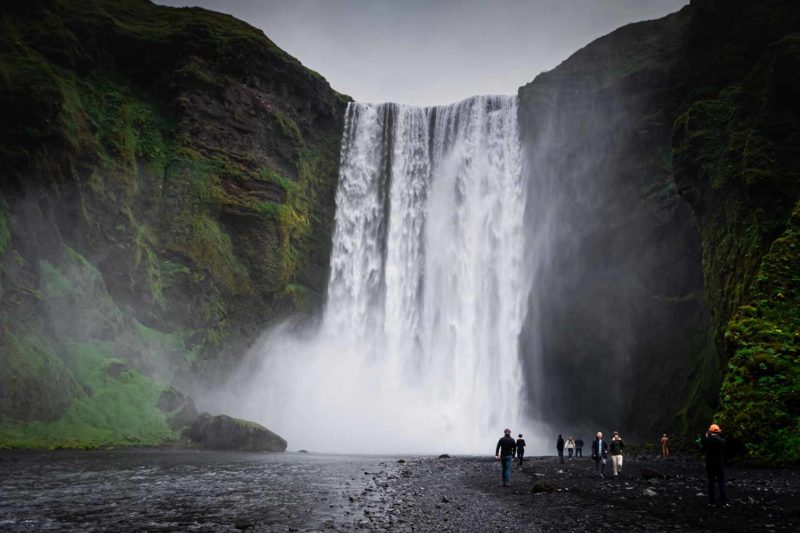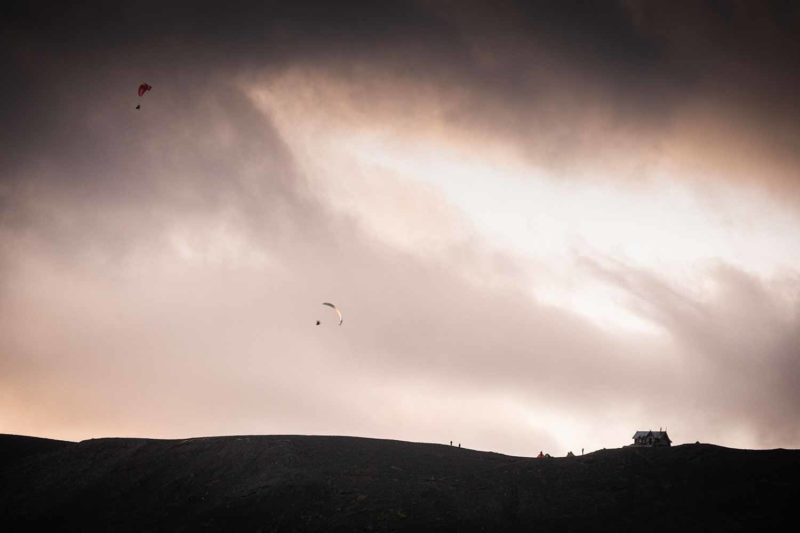I turn, direction Skogar on the south coast to see the Skogafoss waterfall where the Skoga River flows sixty meters high. Two tour buses pass me at a crazy pace on the small dented road. They throw a few meters further at the foot of a fairground-like campsite, a hundred tourists who rush hand in hand to the waterfall. There is not much left of the small village of Skogar where everything seems to have been transformed into a hotel or guesthouse. I leave my bicycle in a corner and cross the campsite to reach the waterfall. Which is impressive. But the atmosphere is nonexistent. At its feet, an uninterrupted stream of photos and selfies rushes and the sound of the water is almost covered by a multi-ethnic bla-bla. Tourists from the organized group overtake me, almost pushing me, all in a hurry to find again the comfort of their bus. It rains a little. And I dream of an Iceland that has disappeared.
The south coast and to a lesser extent the rest of Iceland now seems to be just a gigantic open-air attraction. In the space of ten years, social networks have generated a mass tourism invading the country and storming each place popularized by a multitude of photos all more perfect one than the other. Everyone wants to see the Puffins, the Skogafoss Waterfall, the Jokulsarlon Glacial Lake or the plane wreck on the beach. Me including. I do not deny it. But landing in Iceland, late July 2019, I did not expect this influx of tourists and the consequences that it would cause for me and my trip.
The vast majority of people visiting Iceland are either tourists who came here for a dozen days and touring the island by rental car, mainly French, Spanish, American, Scandinavian. Or groups of organized tours traveling in bulk buses. Especially Asians (Chinese) and Italians. They go from tourist places to tourist places, spend a few minutes there, strafe in search of the perfect Instagram photo and leave without even having seen the landscape and understood the environment in which they are. Outside of these tourist places, there is no one, or few people. It must be said that the rest of the country is not very accessible. Apart from a few people like me (and still) in search of calm, solitude and adventure, all make the same superficial trip without understanding and taking an interest in the country they visit.
After a week riding my bike on Route 1, the circular route around Iceland, I was about to stop my trip and return to France. Too many cars driving too fast on the road, an open air circus to all possible interesting places, full or exorbitant pricey accommodation, completely overloaded and in poor condition campsites and nonexistent Icelanders. All this had nothing to do with my idea of travel, my search for an experience in contact with the country and the inhabitants, my desire for an adventure, a solitary confrontation with the elements and nature. Or in any case it was certainly not on the South Coast that I was going to find it.
No. To find what I was looking for, I apparently had to leave the N°1 road and plunge through the tracks of the Highlands. In this desert environment that makes up the center of Iceland. Or go to the Westfjords where the N°1 road does not pass. There, less people. Sort of. A few adventurers and a still lot of tourists looking for something outside the box. It is not yet great loneliness but it approaches it.
My father, great hiker since forever, has never been concerned about the top 10 places to see or other places not to be missed when planning his trips. He always chose in a country that interested him, an area on the map that seemed good for hiking and go. For a trip, an adventure, alone or with the family, looking for something different. He went to Iceland twice. In 1992, with my mother and I, a few years old (I have no memories) and in 2005 with my brother. The first time, without knowing what he was about to get, he crossed the Reykjanes peninsula, the Snæfellsnes peninsula and the Westfjords, on foot and with tent. The second time, he went for a trek on the Vatnajökull glacier and in the western fjords to Glama and Patreksfjördur. On foot and with tent. Both times without following existing paths. Without asking any questions. Without meeting anyone. Both trips had their share of difficulties and bad weather but the memories are unforgettable. And yet he did not see the Iceland of magazines, of Instagram or of Icelandair pubs. No Skogafoss waterfall, no organized horseback rides, no river crossings in big truck tire jeeps. The search for the superficial extraordinary does not interest him.


The Skogafoss waterfall filled with tourists to the left and motorized paragliders over the Fimmvörðuháls ridge.
For me, who is using Facebook and Instagram, when I planned my trip to Iceland a few months ago, although in search of a true adventure, I unconsciously set up a journey following the top 10 of places to see and the most photogenic places according to Instagram. I too found myself on the same trip as everyone, the same tour of Iceland. A sheep among the sheep. But the adventures lived during my childhood are inscribed in me. This relationship to respectful travel, real adventure, transmitted by my father. So inevitably when I found myself in the middle of the mass of tourists to do like everyone else, I felt cut in half. On one side I wanted to go see all of the supposedly unmissable places. On the other, I longed to be alone in nature to confront myself physically and mentally.
So I went through these more difficult places. Without going completely wild as my father did, but approaching me as much as possible. Because despite my search for adventure, I am not yet able to do it completely alone. I do not have a strong enough mind. Whether it is in Iceland or anywhere else, Nigeria, France, Patagonia, Greenland or others, most of the countries are now facing a mass of tourists that is growing importantly. What is also bothers me with this increase in mass tourism, it is the fact that now for people who like me are looking for a respectful trip, quiet and in contact with nature, some areas of the country seem to be out of reach. Or only accessible outside tourist season and therefore only during difficult weather conditions. Do I have to accept to not go to some of the country’s so-called “attractions” to cover only those places that are more difficult to access? And how to manage the increase of tourism? Is it necessary to confine this affluence to a part of the country, even if it is going to destroy it? To leave the rest protected, untouched, wild and traveled only by adventurous and respectful travelers?
My father continues to hike, every weekend in France and during his holidays, abroad. He continues to choose his destinations according to his interest and places where it is possible to hike a few days without too much difficulty and without getting lost. In an unknown country, estimating difficulty and learning about the environment are two very important factors. Especially if you want to think outside the box. And rather than confronting everyone’s dream life, this permanent search for extraordinary, he makes “simple” trips full of unexpected, random things, without worrying about the places supposedly not to be missed. Because beyond the discovery of new landscapes, travelling for my father is a search for simplicity and for an inner feeling. His travel. And not that of others. And that is probably what travel means.
